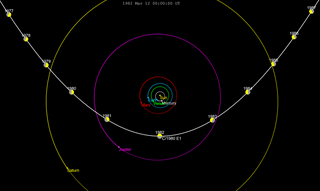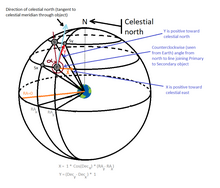
Comet Machholz, formally designated C/2004 Q2, is a long-period comet discovered by Donald Machholz on August 27, 2004. It reached naked eye brightness in January 2005. Unusual for such a relatively bright comet, its perihelion was farther from the Sun than the Earth's orbit.

Comet C/2006 M4 (SWAN) is a non-periodic comet discovered in late June 2006 by Robert D. Matson of Irvine, California and Michael Mattiazzo of Adelaide, South Australia in publicly available images of the Solar and Heliospheric Observatory (SOHO). These images were captured by the Solar Wind ANisotropies (SWAN) Lyman-alpha all-sky camera on board the SOHO. The comet was officially announced after a ground-based confirmation by Robert McNaught on July 12.
Jet Propulsion Laboratory Development Ephemeris designates one of a series of mathematical models of the Solar System produced at the Jet Propulsion Laboratory in Pasadena, California, for use in spacecraft navigation and astronomy. The models consist of numeric representations of positions, velocities and accelerations of major Solar System bodies, tabulated at equally spaced intervals of time, covering a specified span of years. Barycentric rectangular coordinates of the Sun, eight major planets and Pluto, and geocentric coordinates of the Moon are tabulated.

C/1980 E1 is a non-periodic comet discovered by Edward L. G. Bowell on 11 February 1980 and which came closest to the Sun (perihelion) in March 1982. It is leaving the Solar System on a hyperbolic trajectory due to a close approach to Jupiter. In the 42 years since its discovery only two objects with higher eccentricities have been identified, 1I/ʻOumuamua (1.2) and 2I/Borisov (3.35).

C/2007 Q3 , is an Oort cloud comet that was discovered by Donna Burton in 2007 at Siding Spring Observatory in New South Wales, Australia. Siding Spring came within 1.2 astronomical units of Earth and 2.25 AU of the Sun on October 7, 2009. The comet was visible with binoculars until January 2010.
C/2000 W1 (Utsunomiya–Jones) is a long-period comet from the Oort cloud discovered on November 18, 2000, by Syogo Utsunomiya and Albert F. A. L. Jones. The comet reached up to apparent magnitude 5.5, but was only 27 degrees from the Sun in mid-December 2000.
C/1999 F1 (Catalina) is one of the longest known long-period comets. It was discovered on March 23, 1999, by the Catalina Sky Survey. The current perihelion point is outside of the inner Solar System which helps reduce planetary perturbations to this outer Oort cloud object.

2012 DR30 is a trans-Neptunian object and centaur from the scattered disk and/or inner Oort cloud, located in the outermost region of the Solar System. The object with a highly eccentric orbit of 0.99 was first observed by astronomers with the Spacewatch program at Steward Observatory on 31 March 2009. It measures approximately 188 kilometers (120 miles) in diameter.
C/2013 V5 (Oukaimeden) is a retrograde Oort cloud comet discovered on 12 November 2013 by Oukaimeden Observatory at an apparent magnitude of 19.4 using a 0.5-meter (20 in) reflecting telescope.
2010 BK118 (also written 2010 BK118) is a centaur roughly 20–60 km in diameter. It is on a retrograde cometary orbit. It has a barycentric semi-major axis (average distance from the Sun) of ~400 AU.
(418993) 2009 MS9, provisionally known as 2009 MS9, is a centaur roughly 30–60 km in diameter. It has a highly inclined orbit and a barycentric semi-major axis (average distance from the Sun) of ~353 AU.

C/2017 K2 (PanSTARRS) is an Oort cloud comet with an inbound hyperbolic orbit, discovered in May 2017 at a distance beyond the orbit of Saturn when it was 16 AU (2.4 billion km) from the Sun. Precovery images from 2013 were located by July. It had been in the constellation of Draco from July 2007 until August 2020. As of June 2022, the 3-sigma uncertainty in the current distance of the comet from the Sun is ±5000 km. The comet is record breaking because it is already becoming active at such a distance. Only Comet Hale–Bopp produced such a show from that distance with a similar nucleus. However, this comet will not be as visible as Hale–Bopp was in 1997 in part because it does not come nearly as close to the Sun. Astronomers had never seen an active inbound comet this far out, where sunlight is 1/225th its brightness as seen from Earth. Temperatures, correspondingly, are at -440 °F (-262 °C) in the Oort cloud. However, as it was approaching the Sun at a distance of 16 AU at discovery, a mix of ancient ices on the surface containing oxygen, nitrogen, carbon dioxide and carbon monoxide began to sublimate and shed the dust frozen into it. This material expands into a vast 130,000 km (81,000 mi) wide halo of dust, called a coma, enveloping the solid nucleus.

C/2017 U7 (PanSTARRS) is a hyperbolic comet, first observed on 29 October 2017 by astronomers of the Pan-STARRS facility at Haleakala Observatory, Hawaii, United States when the object was 7.8 AU (1.2 billion km) from the Sun. Despite being discovered only 10 days after interstellar asteroid 1I/'Oumuamua, it was not announced until March 2018 as its orbit is not strongly hyperbolic beyond most Oort Cloud comets. Based on the absolute magnitude of 10.6, it may measure tens of kilometers in diameter. As of August 2018, there is only 1 hyperbolic asteroid known, ʻOumuamua, but hundreds of hyperbolic comets are known.

C/2018 C2 (Lemmon) is a hyperbolic comet. It was first observed on 5 February 2018 by the Mount Lemmon Survey conducted at the Mount Lemmon Observatory near Tucson, Arizona, in the United States. The discovery was announced on 4 March 2018 along with another hyperbolic object, A/2017 U7. Based on the absolute magnitude of 15.1, it may measure several kilometers in diameter. On 22 March 2018 it was determined to be a hyperbolic comet.
C/2010 U3 (Boattini) is the hyperbolic comet with the longest observation arc and took around a million years to complete half an orbit from its furthest distance in the Oort cloud. It was discovered on 31 October 2010 by Andrea Boattini in images taken with the Mount Lemmon Survey's 1.5-m reflector. The perihelion point is outside of the inner Solar System.
C/2021 O3 (PanSTARRS) was an Oort cloud comet, discovered on 26 July 2021 by the Pan-STARRS sky survey. It came to perihelion on 21 April 2022 at 0.287 AU (42.9 million km). from the Sun.
C/2002 VQ94 (LINEAR) is a long period comet with a comet nucleus estimated to be ≈100 km in diameter. It was discovered on 11 November 2002 by LINEAR. It only brightened to total apparent magnitude 15.7 because the perihelion point of 6.7 AU (1.0 billion km) was outside of the inner Solar System.
2021 RR205 is an extreme trans-Neptunian object and sednoid discovered by astronomers Scott Sheppard, David Tholen, and Chad Trujillo with the Subaru Telescope at Mauna Kea Observatory on 5 September 2021. It resides beyond the outer extent of the Kuiper belt on a distant and highly eccentric orbit detached from Neptune's gravitational influence, with a large perihelion distance of 55.5 astronomical units (AU). Its large orbital semi-major axis (~1,000 AU) suggests it is potentially from the inner Oort cloud. Like 2013 SY99, 2021 RR205 lies in the 50–75 AU perihelion gap that separates the detached objects from the more distant sednoids; dynamical studies indicate that such objects in the inner edge this gap weakly experience "diffusion", or inward orbital migration due to minuscule perturbations by Neptune.








